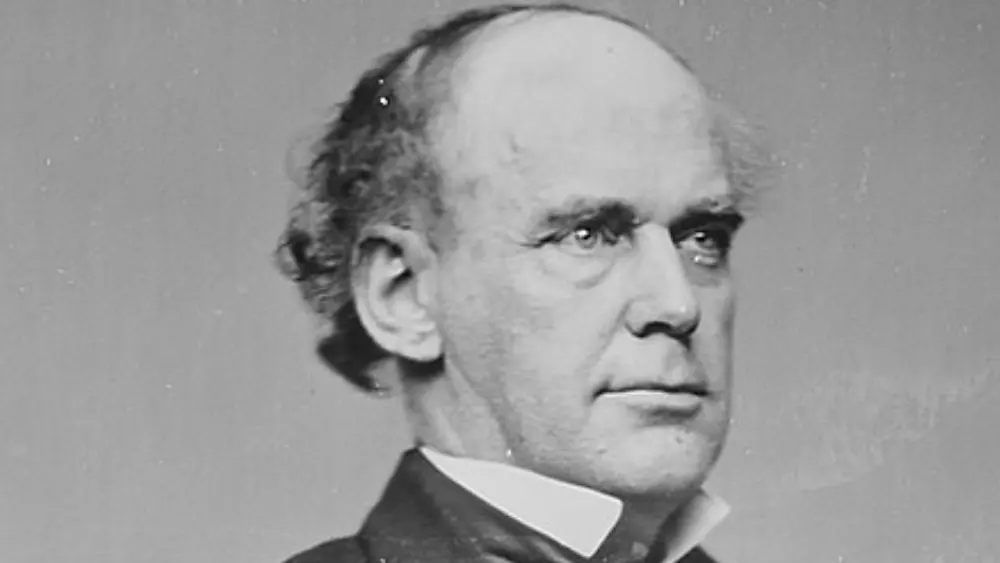Salmon P. Chase, a prominent American statesman and jurist, played a pivotal role in shaping the economic landscape of the United States during the 19th century. Born on January 13, 1808, in Cornish, New Hampshire, Chase’s enduring legacy is deeply intertwined with his contributions to American finance, particularly during a time of significant national upheaval.
Early Years and Legal Career
Salmon P. Chase’s early years were characterized by a strong commitment to education and a burgeoning interest in the legal profession. Born on January 13, 1808, in Cornish, New Hampshire, Chase’s intellectual curiosity led him to Dartmouth College, where he pursued his studies with dedication. Following his graduation, he delved into the field of law, honing his skills and establishing a reputation for legal acumen. Chase’s commitment to justice and his belief in the importance of equal rights positioned him as a prominent figure within legal circles.
As his legal career flourished, Chase became known for his advocacy on behalf of anti-slavery causes, foreshadowing his later role as a key figure in the abolitionist movement. His early experiences in law not only shaped his professional trajectory but also laid the groundwork for his future involvement in the political and social issues that would define his legacy in American history.
Salmon P. Chase: Anti-Slavery Advocacy and Political Ascent
Salmon P. Chase’s political career unfolded during an unruly period marked by the intensifying debate over slavery in the United States. Embracing a staunch anti-slavery stance, Chase emerged as a leading figure in the abolitionist movement, distinguishing himself for his unwavering commitment to the cause. His dedication to the principles of freedom and equal rights propelled him into the political arena, where he first aligned himself with the Free Soil Party, a political faction opposed to the expansion of slavery into new territories.
Chase’s political ascent continued as he transitioned to the newly formed Republican Party, which had a strong anti-slavery platform. His leadership within the party, coupled with his advocacy for the abolition of slavery, garnered him increased visibility and influence. Chase’s commitment to the abolitionist cause and his growing political prominence positioned him as a key player in the unfolding drama that would eventually lead to the Civil War and the profound transformation of American society.
Ohio Governorship and U.S. Senate
Salmon P. Chase’s political journey reached a significant milestone when he assumed the governorship of Ohio, a position he held from 1856 to 1860. In this role, Chase continued to champion anti-slavery principles, earning recognition for his commitment to the cause. As governor, he faced the challenges of a nation on the brink of division over the issue of slavery, navigating the complex political landscape of a state positioned at the heart of the growing tensions between the North and the South.
Following his tenure as governor, Chase’s political trajectory advanced to the national stage as he transitioned to the United States Senate. Serving as a U.S. Senator from Ohio from 1861 to 1864, Chase further solidified his influence in national politics. His unwavering dedication to anti-slavery ideals and his role as a prominent Republican figure positioned him as a key player in the unfolding events that would lead to the Civil War. Chase’s tenure in the U.S. Senate marked a pivotal chapter in his political career, as he continued to play a crucial role in shaping the direction of the nation during this unruly period in American history.
Salmon P. Chase: Architect of the Treasury and Financial Policies
A pivotal chapter in Salmon P. Chase’s distinguished career unfolded when he assumed the role of Secretary of the Treasury under President Abraham Lincoln in 1861. Entrusted with the monumental task of managing the nation’s finances during the unruly years of the Civil War, Chase brought his astute financial acumen and dedication to principled governance to the forefront. As the architect of the Treasury, he faced the unprecedented challenge of funding the Union war effort, requiring creative and far-reaching financial measures to sustain the North’s military operations.
In response to the financial demands of the war, Chase implemented bold and innovative policies that would leave a lasting impact on the nation’s financial system. He spearheaded the issuance of the first national paper currency, known as “greenbacks,” to help finance the war and stabilize the economy. Additionally, Chase played a key role in the establishment of the National Banking System, which aimed to provide a more stable and uniform currency. His tenure as Secretary of the Treasury showcased his ability to navigate the complexities of wartime finance and implement strategic policies that would contribute significantly to the Union’s ultimate success in the Civil War.
National Banking System and Greenbacks
Salmon P. Chase’s tenure as Secretary of the Treasury was marked by significant financial innovations, most notably the establishment of the National Banking System. Enacted in 1863, this ambitious initiative aimed to create a more stable and uniform banking system across the United States. The National Banking System introduced a national currency and established a network of nationally chartered banks, providing a foundation for the modern banking system and contributing to the stability of the nation’s financial institutions.
In addition to the establishment of the National Banking System, Chase played a pivotal role in the issuance of “greenbacks,” a form of fiat currency, to finance the Union’s war effort during the Civil War. These greenbacks were unbacked by a specific commodity like gold or silver but were crucial in meeting the pressing financial needs of the government during a period of intense conflict. Chase’s foresight and financial acumen were instrumental in navigating the complexities of wartime finance, and his contributions to the development of the National Banking System and the issuance of greenbacks left a lasting impact on the trajectory of American financial policy.
Salmon P. Chase: Chase’s Ambitions and Supreme Court Appointment
Salmon P. Chase’s political aspirations extended beyond his role as Secretary of the Treasury, as he harbored ambitions for the presidency. In 1860, he sought the Republican nomination for president but faced strong competition from Abraham Lincoln, who ultimately secured the nomination and won the presidency. Despite this setback, Chase’s political career took an unexpected turn when President Lincoln appointed him as the Chief Justice of the United States Supreme Court in 1864.
Chase’s tenure as Chief Justice spanned nearly a decade, lasting until his death in 1873. As the head of the Supreme Court, he presided over a period of significant legal and constitutional developments, including cases related to Reconstruction and issues arising from the aftermath of the Civil War. While Chase did not achieve his presidential ambitions, his appointment as Chief Justice allowed him to leave a lasting imprint on the nation’s legal landscape, contributing to the Court’s jurisprudence during a pivotal period in American history.
Judicial Legacy and Constitutional Interpretation
Salmon P. Chase’s legacy as Chief Justice is marked by his contributions to significant decisions that left a lasting impact on constitutional law. One notable case during his tenure was Ex parte Milligan (1866), where the Supreme Court addressed the constitutionality of trying civilians in military tribunals during times of war. In a landmark decision, Chase joined the majority in ruling that the use of military tribunals for civilians in areas where civil courts were functioning was unconstitutional. This decision reinforced the principle of civilian jurisdiction over civilians during peacetime, even in the midst of armed conflict.
Chase’s approach to constitutional interpretation emphasized a commitment to individual rights and the rule of law. His jurisprudence reflected a belief in the importance of safeguarding constitutional liberties, particularly in times of national crisis. Chase’s tenure as Chief Justice and his contributions to decisions like Ex parte Milligan underscored his dedication to upholding the principles of the Constitution and ensuring the protection of individual rights within the framework of American law.

Salmon P. Chase: Legacy and Commemoration
Salmon P. Chase’s legacy remains deeply ingrained in American history, with enduring recognition for his multifaceted contributions to the nation. His pivotal role as Secretary of the Treasury, where he orchestrated innovative financial policies during the Civil War, solidified his reputation as a key figure in shaping the economic trajectory of the United States. Chase’s influence reached far beyond finance, with his tenure as Chief Justice of the Supreme Court leaving a lasting impact on constitutional law, especially in areas concerning individual rights and the rule of law.
To commemorate his legacy, Chase’s image adorned the United States ten-thousand-dollar bill, a testament to the significance of his financial policies. His impact on the nation’s economic and legal frameworks ensures that Salmon P. Chase is remembered as a statesman whose contributions reverberate through the corridors of both financial and judicial history.










